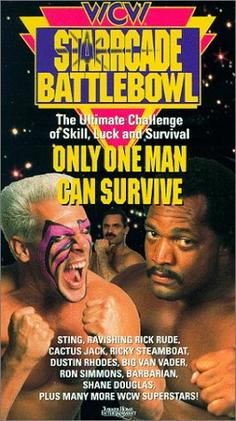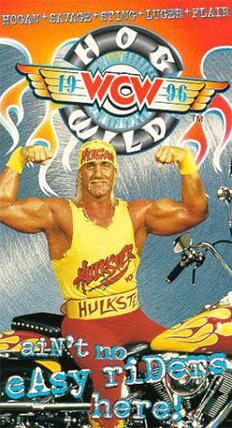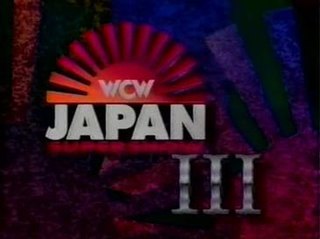
The New World Order was an American professional wrestling group who originally consisted of "Hollywood" Hulk Hogan, Scott Hall, and Kevin Nash.

Keiji Muto is a Japanese professional wrestling executive, actor and retired professional wrestler. He is known for his work under his real name and as his alter ego The Great Muta in New Japan Pro-Wrestling (NJPW), as well as World Championship Wrestling (WCW) and during the 1980s and 1990s, and from his runs in other Japanese, American, Puerto Rican, and Mexican promotions. He was the president of All Japan Pro Wrestling (AJPW) from 2002 to 2013 and representative director of Wrestle-1 (W-1) from 2013 until its closure in 2020.

The WCW International World Heavyweight Championship was a professional wrestling world heavyweight championship that was contested in World Championship Wrestling (WCW) between 1993 and 1994. Although it was owned and controlled by WCW, the championship was presented as the highest accolade of "WCW International", a fictitious subsidiary. The championship was contested at WCW events and at several events in Japan under the aegis of New Japan Pro-Wrestling (NJPW).

Masahiro Chono is a Japanese-American retired professional wrestler and actor best known for his 26-year stint with New Japan Pro-Wrestling (NJPW). As the leader of nWo Japan, Team 2000 and Black New Japan, he was the promotion's top heel for much of his career, beginning in 1994 when he adopted a yakuza inspired gimmick.

Collision in Korea, officially known as the Pyongyang International Sports and Culture Festival for Peace, was a professional wrestling pay-per-view (PPV) event jointly produced by New Japan Pro-Wrestling (NJPW) and World Championship Wrestling (WCW). The event featured 15 matches over two evenings on April 28 and 29, 1995, at May Day Stadium in Pyongyang, North Korea. It aired in North America on August 4, 1995, when WCW broadcast a selection of eight matches from the show on pay-per-view. It was the first event hosted by an American professional wrestling promotion in the country.
Wrestling Dontaku 1993 was the first Wrestling Dontaku professional wrestling event produced by New Japan Pro-Wrestling (NJPW). The event took place on May 3, 1993, in Fukuoka, Fukuoka at the Fukuoka Dome. As part of working relationships between NJPW and American promotions World Championship Wrestling (WCW) and World Wrestling Federation (WWF), WCW's Sting and WWF's Brutus Beefcake, Hulk Hogan and Jimmy Hart took part in the event. Professional wrestlers from Japanese promotion Wrestle and Romance (WAR) also appeared at the event.
Wrestling Dontaku (1995) was the third Wrestling Dontaku professional wrestling event produced by New Japan Pro-Wrestling (NJPW), held on May 3, 1995, in Fukuoka, Fukuoka, at the Fukuoka Dome.
Wrestling Dontaku 1994 was the second Wrestling Dontaku professional wrestling event produced by New Japan Pro-Wrestling (NJPW). The event was held on May 1, 1994, in Fukuoka, Fukuoka, at the Fukuoka Dome. The event featured thirteen matches; three of which were contested for championships.

Fantastic Story in Tokyo Dome was a professional wrestling event co-produced by the New Japan Pro-Wrestling (NJPW) and World Championship Wrestling (WCW) promotions. The show took place on January 4, 1993 in Tokyo's Tokyo Dome. Officially, the show drew 63,500 spectators and $3,200,000 in ticket sales. This was the second year that the show was co-promoted by the American WCW promotion. The show featured 10 matches, including four matches that featured WCW wrestlers.

Wrestling World 1997 was a professional wrestling event co-produced by the New Japan Pro-Wrestling (NJPW) and Big Japan Pro Wrestling (BJW) promotions. It took place on January 4, 1997 in the Tokyo Dome. Officially, the show drew 62,500 spectators and $5,000,000 in ticket sales. The show featured 12 matches, including four matches that were promoted jointly with the BJW promotion and presented as a rivalry between the two promotions. The show featured 12 matches in total, including three title matches, two of which saw new champions crowned.

Starrcade '92: Battlebowl – The Lethal Lottery II was the 10th annual Starrcade professional wrestling pay-per-view (PPV) event produced by World Championship Wrestling (WCW). It was broadcast December 28, 1992, from The Omni in Atlanta, Georgia.

WrestleWar '92 was the fourth and final WrestleWar professional wrestling pay-per-view (PPV) event produced by World Championship Wrestling (WCW). It took place on May 17, 1992, from the Jacksonville Memorial Coliseum in Jacksonville, Florida in the United States. In 1993, WrestleWar was replaced by Slamboree as the May PPV and the event’s WarGames match moved to September’s Fall Brawl.

The 1991 Halloween Havoc was the third annual Halloween Havoc professional wrestling pay-per-view (PPV) event produced by World Championship Wrestling (WCW). The event took place on October 27, 1991, from the UTC Arena in Chattanooga, Tennessee. This was also the first Halloween Havoc held by WCW alone following its split from the National Wrestling Alliance (NWA) in January 1991.

The 1996 Hog Wild was a professional wrestling pay-per-view (PPV) event produced by World Championship Wrestling (WCW) and the first in the Road Wild chronology. It took place on August 10, 1996, from the Sturgis Motorcycle Rally in Sturgis, South Dakota in the United States. The event took place on a Saturday instead of the Sunday more typical for pay-per-view events.

The 1992 Halloween Havoc was the fourth annual Halloween Havoc professional wrestling pay-per-view (PPV) event produced by World Championship Wrestling (WCW). It took place on October 25, 1992, from the Philadelphia Civic Center in Philadelphia, Pennsylvania in the United States — this was the second Halloween Havoc held at this venue after the inaugural event in 1989. In 2014, the event was made available on WWE's streaming service, the WWE Network.

WCW/New Japan Supershow I, was a professional wrestling pay-per-view (PPV) event that took place on March 21, 1991, in the Tokyo Dome in Tokyo, Japan. It was co-promoted by New Japan Pro-Wrestling (NJPW), who hosted the event, and the US-Based World Championship Wrestling (WCW), which supplied a number of the wrestlers on the show. The event was the inaugural WCW/New Japan Supershow.

WCW/New Japan Supershow III took place on January 4, 1993, in the Tokyo Dome in Tokyo, Japan. The show would be the third and final show available on pay-per-view (PPV) in America under the name WCW/New Japan Supershow. In Japan it was promoted under the name "Fantastic Story in Tokyo Dome" and was the second annual NJPW January 4 Dome Show, NJPW's premier event of the year.
The 1996 Battle Formation was the first Battle Formation event produced by New Japan Pro-Wrestling. The event was held on April 29, 1996 at the Tokyo Dome in Tokyo, Japan. It was a major success with a crowd of estimated 60,000 people and an approximate revenue of $5,700,000 from ticket sales. The event featured competitors from various promotions including Michinoku Pro Wrestling, New Japan Pro-Wrestling, Union of Wrestling Forces International, World Championship Wrestling and Wrestle Association R.
The 1997 Battle Formation was the second and final Battle Formation event produced by New Japan Pro-Wrestling, which took place on April 12, 1997 at the Tokyo Dome in Tokyo, Japan. It was a massive success, drawing a crowd of about 60,000 fans and the revenue generated from ticket sales amounted to $5,000,000.
Strong Style Evolution was a professional wrestling event produced by New Japan Pro-Wrestling (NJPW). It took place on May 3, 1997 at the Osaka Dome in Osaka, Japan.













